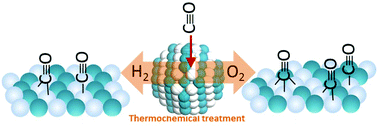Our official English website, www.x-mol.net, welcomes your
feedback! (Note: you will need to create a separate account there.)
Evolution of surface catalytic sites on thermochemically-tuned gold–palladium nanoalloys†
Nanoscale ( IF 5.8 ) Pub Date : 2018-02-08 00:00:00 , DOI: 10.1039/c7nr08748a Haval Kareem 1, 2, 3, 4 , Shiyao Shan 1, 2, 3, 4 , Fang Lin 1, 2, 3, 4 , Jing Li 1, 2, 3, 4 , Zhipeng Wu 1, 2, 3, 4 , Binay Prasai 4, 5, 6, 7 , Casey P. O'Brien 4, 8, 9, 10 , Ivan C. Lee 4, 8, 9, 10 , Dat T. Tran 4, 8, 9, 10 , Lefu Yang 11, 12, 13, 14 , Derrick Mott 15, 16, 17, 18 , Jin Luo 1, 2, 3, 4 , Valeri Petkov 4, 5, 6, 7 , Chuan-Jian Zhong 1, 2, 3, 4
Nanoscale ( IF 5.8 ) Pub Date : 2018-02-08 00:00:00 , DOI: 10.1039/c7nr08748a Haval Kareem 1, 2, 3, 4 , Shiyao Shan 1, 2, 3, 4 , Fang Lin 1, 2, 3, 4 , Jing Li 1, 2, 3, 4 , Zhipeng Wu 1, 2, 3, 4 , Binay Prasai 4, 5, 6, 7 , Casey P. O'Brien 4, 8, 9, 10 , Ivan C. Lee 4, 8, 9, 10 , Dat T. Tran 4, 8, 9, 10 , Lefu Yang 11, 12, 13, 14 , Derrick Mott 15, 16, 17, 18 , Jin Luo 1, 2, 3, 4 , Valeri Petkov 4, 5, 6, 7 , Chuan-Jian Zhong 1, 2, 3, 4
Affiliation

|
Nanoscale alloying constitutes an increasingly-important pathway for design of catalysts for a wide range of technologically important reactions. A key challenge is the ability to control the surface catalytic sites in terms of the alloying composition, thermochemical treatment and phase in correlation with the catalytic properties. Herein we show novel findings of the nanoscale evolution of surface catalytic sites on thermochemically-tuned gold–palladium nanoalloys by probing CO adsorption and oxidation using in situ diffuse reflectance infrared Fourier transform spectroscopy (DRIFTS) technique. In addition to the bimetallic composition and the support, the surface sites are shown to depend strongly on the thermochemical treatment condition, demonstrating that the ratio of three-fold vs. bridge or atop Pd sites is greatly reduced by thermochemical treatment under hydrogen in comparison with that under oxygen. This type of surface reconstruction is further supported by synchrotron high-energy X-ray diffraction coupled to atomic pair distribution function (HE-XRD/PDF) analysis of the nanoalloy structure, revealing an enhanced degree of random alloying for the catalysts thermochemically treated under hydrogen. The nanoscale alloying and surface site evolution characteristics were found to correlate strongly with the catalytic activity of CO oxidation. These findings have significant implications for the nanoalloy-based design of catalytic synergy.
中文翻译:

热化学调谐金钯纳米合金表面催化位点的演变†
纳米级合金化构成了设计用于各种重要技术反应的催化剂的日益重要的途径。关键的挑战是在合金成分,热化学处理和与催化性能相关的相方面控制表面催化部位的能力。在这里,我们通过使用原位漫反射红外傅里叶变换光谱(DRIFTS)技术探测CO吸附和氧化,显示了在热化学调谐的金-钯纳米合金上表面催化位点的纳米尺度演化的新发现。除双金属成分和载体外,表面位置还显示出强烈依赖于热化学处理条件,这表明三倍比是三倍。与氧气相比,在氢气中进行热化学处理可以大大减少Pd桥位或顶部的Pd位。同步加速器高能X射线衍射与纳米合金结构的原子对分布函数(HE-XRD / PDF)分析相结合,进一步支持了这种类型的表面重建,揭示了在氢气中热化学处理的催化剂的无规合金化程度提高了。发现纳米级合金化和表面位点演化特征与CO氧化的催化活性强烈相关。这些发现对基于纳米合金的催化协同设计具有重要意义。
更新日期:2018-02-08
中文翻译:

热化学调谐金钯纳米合金表面催化位点的演变†
纳米级合金化构成了设计用于各种重要技术反应的催化剂的日益重要的途径。关键的挑战是在合金成分,热化学处理和与催化性能相关的相方面控制表面催化部位的能力。在这里,我们通过使用原位漫反射红外傅里叶变换光谱(DRIFTS)技术探测CO吸附和氧化,显示了在热化学调谐的金-钯纳米合金上表面催化位点的纳米尺度演化的新发现。除双金属成分和载体外,表面位置还显示出强烈依赖于热化学处理条件,这表明三倍比是三倍。与氧气相比,在氢气中进行热化学处理可以大大减少Pd桥位或顶部的Pd位。同步加速器高能X射线衍射与纳米合金结构的原子对分布函数(HE-XRD / PDF)分析相结合,进一步支持了这种类型的表面重建,揭示了在氢气中热化学处理的催化剂的无规合金化程度提高了。发现纳米级合金化和表面位点演化特征与CO氧化的催化活性强烈相关。这些发现对基于纳米合金的催化协同设计具有重要意义。











































 京公网安备 11010802027423号
京公网安备 11010802027423号